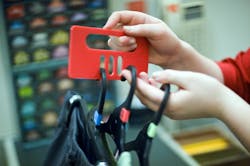According to the results of the 2015 Global Retail Theft Barometer released on Wednesday, shrink, which is comprised of shoplifting, employee or vendor fraud, and administrative errors, increased in the U.S. from 1.28 percent of sales in 2013-2014 to 1.97 percent during 2014-2015. Shrink also rose globally from 0.94 percent to 1.42 percent over that same time period.
The study, underwritten by an independent grant from Checkpoint Systems, consisted of both in-depth phone and written survey interviews conducted in 24 countries among more than 200 retailers representing nearly $1 trillion in sales. Overall, respondents reported a shrinkage rate of 1.23 percent across 18 retail verticals resulting in more than $123 billion lost by retailers globally during 2014-2015.
Ernie Deyle, a retail loss prevention analyst who along with global professional services firm The Smart Cube helped author the study, said that the “erosion in performance” by retailers in reducing shrink was one of the most surprising findings of the survey, which he believes can be attributed to a downturned economy combined with a decrease in money spent by retailers on combatting theft.
“One of the common, atypical causes of increased shrink risk is a decrease in spend related to countermeasures, tactics, tools, and capital dedicated to defending against loss. That went down this year and, as a result, it’s like a seesaw if you will, your spend goes down and shrink does up,” explained Deyle.
In addition, Deyle said that for the first time globally, retailers reported suffering greater amounts of internal theft than external theft. According to the study, dishonest employee theft accounted for 39 percent of shrink globally during 2014-2015, just one percentage point higher than shoplifting. That’s in sharp contrast to last year’s study in which shoplifting was reported to account for 39 percent of global shrink, compared to employee theft which stood at 28 percent. In the U.S., dishonest employee theft accounted for 45 percent of shrink during 2014-2015, while shoplifting accounted for 36 percent.
“Typically the U.S. has always been the most dominant vertical in the internal theft or employee theft-related activity. But globally when you look at the rest of the world, external theft has always been the big contributor to shrink,” added Deyle. “This year, for the first time, the globe now says internal theft is the leading cause of shrink.”
Some of the study’s other findings pertaining to shrink among U.S. retailers include:
- Apparel stores suffered the highest rate of shrink (2.28 percent) followed by pharmacies/drugstores (2.25 percent) and non-grocery retailers (1.9 percent).
- Shoplifters and dishonest employees in the U.S. primarily targeted small and easy-to-conceal items, as well as high-value items with high resale value, such as tablets. When sorted by retail vertical, the most stolen items included footwear (apparel and fashion accessories); batteries (DIY home improvement); mobile device accessories (electronics); wines and liquor (food and beverage); and razor blades (health and beauty).
- Seasonally, U.S. respondents said that 46 percent of their yearly losses occurred in winter, nearly twice as much as the next season, autumn, at 24 percent. Spring (18 percent) and summer (12 percent) followed.
Deyle believes the advent of advanced data analytics will play a significant role in the years ahead when it comes to helping organizations combat shrink in all of its various forms.
“Retailers have been very data rich in actually having a plethora of information, but they have been very slow to leverage that data in a way to get information that is actionable for them and in a timely manner so they can make decisions and drive performance,” he said. “The number one cause of internal theft is manipulation of point-of-sale transactions when they’re checking out a customer and it happens in a variety of different ways.”
To help curb shoplifting, Deyle said that retailers need to continue to make it as difficult as possible for thieves to take merchandise by utilizing a combination of product protection technologies.
“On the product protection side, the adage has always been if someone is going to come into your store and shoplift, you want them to spend more energy to get less when they can go across the street and spend less energy to get more. You need to put up enough hurdles and enough of a safety net to insulate yourself,” he said.
According to the study, the most common loss prevention store solutions included CCTV/DVR (83 percent), alarm monitoring (78 percent), and security guards (63 percent). The most common merchandise protection solutions deployed to prevent retail theft included electronic article surveillance (EAS) (68 percent), spider wraps/security keepers (41 percent) and advanced inventory control tactics (27 percent).
Click here for more information or to obtain a full copy of the report.


